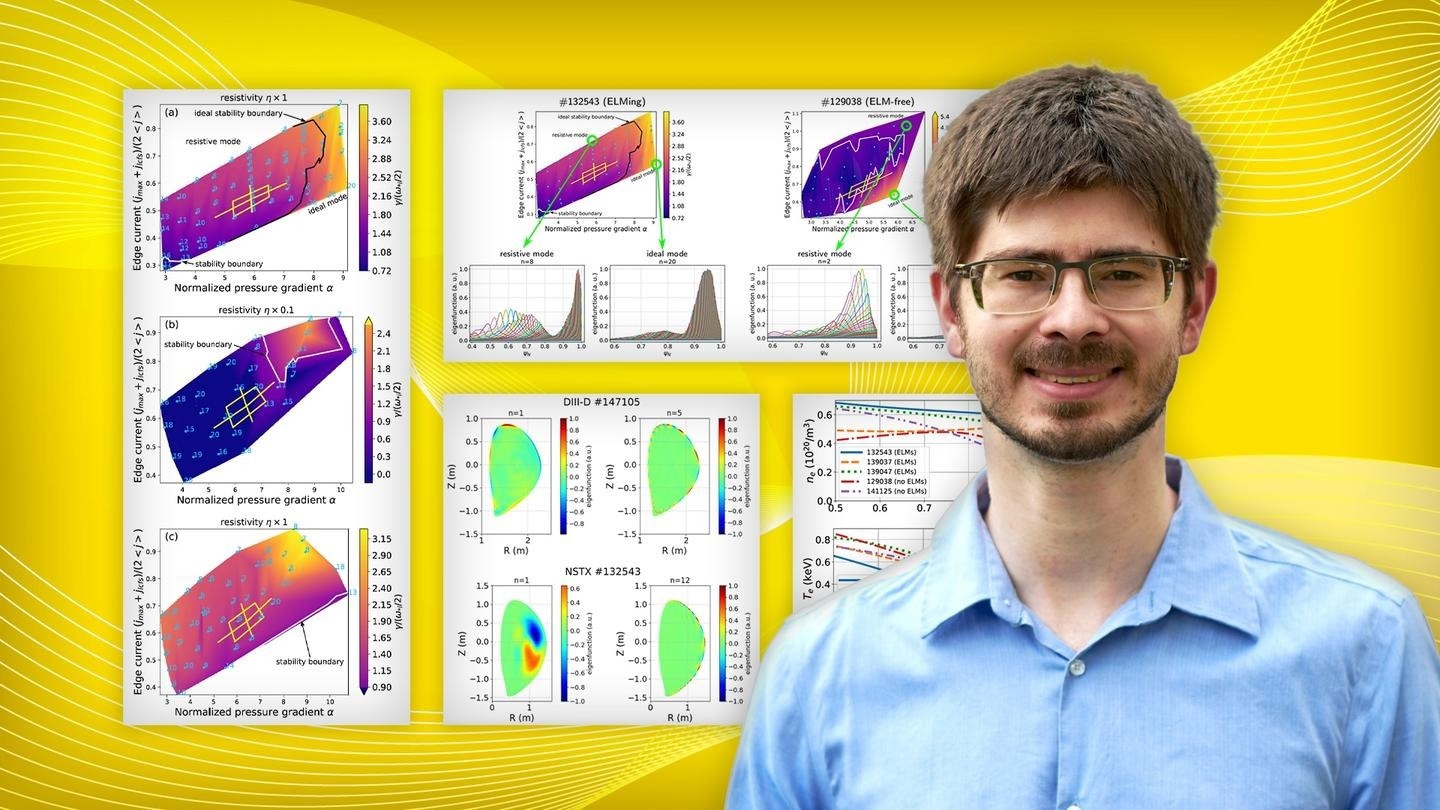At the US Department of Energy’s (DOE) Princeton Plasma Physics Laboratory (PPPL), scientists have discovered that updating a mathematical model to include a physical property called resistivity could result in the enhanced design of doughnut-shaped fusion facilities known as tokamaks.
 PPPL physicist Andreas Kleiner in front of graphs illustrating the phenomena of resistivity in plasma. Image Credit: Kiran Sudarsanan.
PPPL physicist Andreas Kleiner in front of graphs illustrating the phenomena of resistivity in plasma. Image Credit: Kiran Sudarsanan.
Resistivity is the property of any substance that inhibits the flow of electricity. It’s kind of like the viscosity of a fluid, which inhibits things moving through it. For example, a stone will move more slowly through molasses than water, and more slowly through water than through air.
Nathaniel Ferraro, Collaborating Researcher and Physicist, Princeton Plasma Physics Laboratory
Researchers have identified a novel mechanism by which resistivity can contribute to instability at the plasma edge, where pressures and temperatures rapidly increase.
By integrating resistivity into models that anticipate the behavior of plasma, a soup of electrons and atomic nuclei that makes up 99% of the visible universe, scientists can design systems for future fusion facilities that tend to make the plasma more stable.
We want to use this knowledge to figure out how to develop a model that allows us to plug in certain plasma characteristics and predict whether the plasma will be stable before we actually do an experiment. Basically, in this research, we saw that resistivity matters and our models ought to include it.
Andreas Kleiner, Study Lead Author and Physicist, Princeton Plasma Physics Laboratory
Kleiner was the lead author of a study reporting the results in the journal Nuclear Fusion.
Fusion is the power that drives the sun and stars, integrates light elements in the form of plasma — the hot, charged state of matter made of atomic nuclei and free electrons — and produces huge amounts of energy. Researchers seek to exploit fusion on Earth for a virtually inexhaustible supply of power to produce electricity.
Researchers want the plasma to be stable since instabilities can result in plasma eruptions called edge-localized modes (ELMs) that can cause damage to internal components of the tokamak over time, meaning that those components need to be more regularly replaced. Future fusion reactors will have to run without stopping for repairs, however, for months at a time.
We need to have confidence that the plasma in these future facilities will be stable without having to build full-scale prototypes, which is prohibitively expensive and time-consuming. In the case of edge-localized modes and some other phenomena, failing to stabilize the plasma could lead to damage or reduced component lifetimes in these facilities, so it’s very important to get it right.
Nathaniel Ferraro, Collaborating Researcher and Physicist, Princeton Plasma Physics Laboratory
A computer model called EPED has been utilized by physicists to anticipate the behavior of plasma in traditional tokamaks. However, the predictions produced by the code for a range of plasma machines called spherical tokamaks are not always precise.
Physicists are learning spherical tokamaks, small facilities like the National Spherical Tokamak Experiment-Upgrade (NSTX-U) at PPPL that tends to resemble cored apples, as a possible design that has been utilized for a fusion pilot plant.
By making use of the high-powered computers in the National Energy Research Scientific Computing Center, a DOE Office of Science user facility at Lawrence Berkeley National Laboratory in Berkeley, California, Kleiner and the group tried adding resistivity to a plasma model and discovered that the anticipations began to match observations.
“Andreas examined the data from several previous plasma discharges and found that resistive effects were very important. The experiments showed that these effects were probably causing the ELMs we were seeing. The improved model could show us how to change the profiles of plasma in future facilities to get rid of the ELMs,” stated Rajesh Maingi, head of PPPL’s Tokamak Experimental Sciences Department.
Making use of these kinds of computer models is a standard procedure that lets physicists forecast what plasma will do in future fusion machines and design those machines to make the plasma behave in a way to make fusion more likely.
Ferraro stated, “Basically, a model is a set of mathematical equations that describes plasma behavior. And all models incorporate assumptions. Some models, like the one used in this research, describe the plasma as a fluid. In general, you can’t have a model that includes all of physics in it. It would be too hard to solve.”
Ferraro continued, “You want a model that is simple enough to calculate but complete enough to capture the phenomenon you are interested in. Andreas found that resistivity is one of the physical effects that we should include in our models.”
This study builds on past computations that have been conducted by Kleiner and others. It adds to those findings by examining more discharges that are produced by NSTX, the machine preceding NSTX-U, and investigating scenarios when ELMs do not happen. The study also helped the scientists to identify that instabilities were caused by resistivity and are driven not by pressure but by plasma current.
Research that will take place in the future will concentrate on identifying why resistivity produces such kinds of instabilities in spherical tokamaks.
“We do not yet know which property causes the resistive modes at the plasma edge to appear. It might be a result of the spherical torus geometry, the lithium that coats the insides of some facilities, or the plasma’s elongated shape. But this needs to be confirmed with further simulations,” stated Kleiner.
This study was financially supported by the DOE’s Office of Science (Fusion Energy Sciences). Collaborating institutions include the Instituto de Física at Brazil’s University of São Paulo.
Journal Reference:
Kleiner, A., et al. (2022) Critical role of current-driven instabilities for ELMs in NSTX. Nuclear Fusion. doi.org/10.1088/1741-4326/ac64b3.